We all want to be immortal through memories and deeds that we do. Learning the art of Japanese Bonsai does not just make you immortal but a patron of art. Even when you cease to exist, a part of you and your vision will live on through your timeless tree.
It is not just a tree planted in a small pot, but years of patience and knowledge put in a living prodigy. The wonder of Bonsai’s world is an asset to humanity and, the many talented sensei of this art has been looking after them for generations. Not everyone can make or take care of a bonsai. You need to learn the techniques and master skills.
If you are a person who wants to learn more about Japanese Bonsai, remember, it is never too late. Learn how to make your Bonsai and be a loyal patron of this dying art.
To pique, your interest let us dig a bit deeper and know about the origin. A bonsai is an art form where miniature replicas of real-life trees are made, or landscapes are captured in a pot. The trees portray all the characteristics of a full-grown tree and represent nature in all its proper form.
Even though Japan comes to mind when we think of Bonsai, this art form came into being when scholars and students brought back tiny plants in a pot from China. Bonsai can be seen in many parts of Asia but known to each culture in its native name.
Every single one has its uniqueness and a different story to tell. Japanese Bonsai replicates life-like trees and tells us about the ethics, beliefs, and aesthetics that the Japanese believe in. It symbolizes an artist’s emotions and ideas and holds up the different elements of nature in an artistic way.
Check out those videos to under the beauty of Bonsai.
Aesthetics

The bonsai aesthetic is the essence of the art that has been perfected over the years. Since the early days, aesthetics played an essential role in the art of bonsai making. Here the balance of nature, time, and the artistic view is represented in a harmonious way that is simple yet mesmerizing.
Bonsai aesthetics evolved over the last few decades, and now you have lots of different aesthetics to choose from. Few of the different types include
Miniaturization
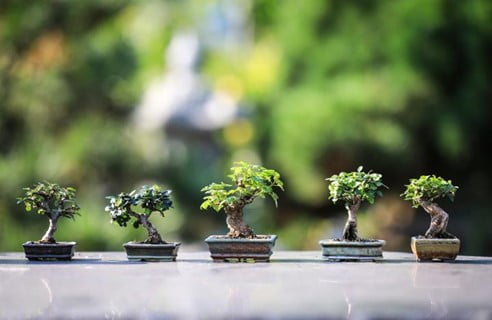
The most crucial aesthetic that must be there in a plant to be called Bonsai. You might look at the Bonsai and wonder what magic is done to have such tiny leaves. Well, it is nothing, but skills learned over the years. One needs to train and maintain a bonsai to keep the whole balance of the tree.
Having a small trunk but big is not something that is accepted. You can maintain the leave by keeping it under grow light, pruning and trimming foliage often, and most importantly, choose a plant that has small leaves.
Leaf Reduction or Pruning
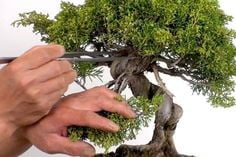
The way a master of Bonsai makes the leaf reduction shows his skills and his artistic views. You need to prune your leave often and maintain them so that the tree’s balance is kept intact.
Ramification
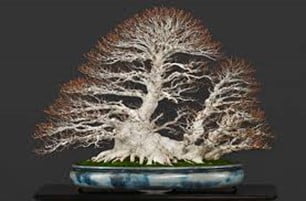
This aesthetic helps the plant look more realistic. It is splitting the branches to control the growth and size of the leaves. The technique is a bit damaging so make sure you do it on a sturdy and healthy tree, which is preferably deciduous. This technique is also known as Hedge Pruning.
This method helps the Bonsai to keep the balance, and miniaturization is possible.
Gravita
This aesthetic binds the whole Bonsai and helps in expressing Wabi or Sabi. It is the process of aging the tree or conveying the age of the Bonsai. As a tree grows old, the tree shows the character of maturity, and to bring that in a bonsai, a master needs to have skilled hands
Lignification
It is a method to bring perfection to the tree trunk and branches by making it look woodier and darker, just like an actual tree. This aesthetic process is not seen in every Bonsai as some maybe have smooth bark. Special tools are required to bring this look to your Bonsai.
Curvature

They have commonly seen in many Bonsai as it can give the Bonsai the weightage in its look and make it look like a mature tree. It is an artistic method that helps the artist master the branches and the trunk so that positive space is created, and all the branches are synchronized. This technique helps it forming the front and gives a picture that appears to the Bonsai.
Deadwood

This is not very common, but maintaining a dead tree that needs many techniques is a method of maintaining a dead tree. It goes well on a few selected trees and looks mesmerizing. It helps the artist to achieve in giving an illusion of age. There are different styles to choose from, and many tools and assistance to achieve each look.
Bonsai Styles

Trees have their way of growing under all circumstances and adversities, which gives them their unique character and shapes them. That is why there is always only one tree of a kind, and there is no look-alike as every branch and every trail is different.
The wind, soil, sunlight, other trees, and surrounding shapes a tree and affects the growth. This gave birth to different styles of Bonsai that we see today. Some styles are listed down below.
- Broom style Bonsai (Hokidachi)Formal upright Bonsai style (Chokkan)
- Informal upright Bonsai style (Moyogi)
- Slanting Bonsai style (Shakan)
- Cascade Bonsai style (Kengai)
- Semi cascade Bonsai style (Han-kengai)
- Literati Bonsai style (Bunjingi)
- Windswept Bonsai style (Fukinagashi)
- Double trunk style Bonsai (Sokan)
- Multitrunk Bonsai style (Kabudachi)
- Forest Bonsai style (Yose-ue)
- Growing on a rock Bonsai style (Seki-joju)
- Growing in a rock Bonsai style (Ishisuki)
How to Make a Bonsai in Budget
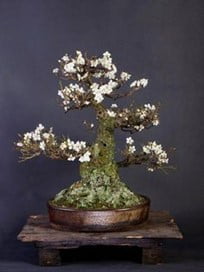
Making a bonsai is easier on the pocket than buying an actual one. But it is not an easy task as a bonsai needs years or patience even to see a single change. That is why we see great Bonsai being hand down generations after generations. Those masterpieces are soothing to the eye, but the one you make yourself would be nothing less.
Follow through those steps to make your very own Bonsai today.
Decide on the species on the tree. Before you choose, you need to consider your climate, the place where you will place the Bonsai, and your skill level. Outdoor Bonsai gives you lots of options to choose from, but you should keep in mind that you do not keep your plant under harsh sunlight or heavy snowfall.
The safest way of choosing your Bonsai is to choose from an indigenous species. You can buy yourself a seed or a seedling and start on your Bonsai, but it will require good knowledge and skills and a minimum of 3 to 5 years before you can start styling. Instead, you can get yourself a pre-bonsai or a nursery stock.
Now you have come to the central part, which is styling and shaping. This depends on the species that you have chosen and your vision, along with your artistic sense. I suggest that you look at a few pictures of the real life-size tree and imitate the characters. Basic techniques that you must do in styling is pruning and wiring. Apart from that, you can learn other advanced techniques over the years.
How to Take Care of Bonsai
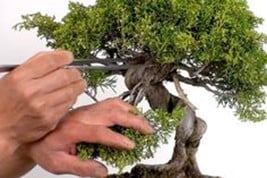
Making a bonsai is taking care of the tree for years and decades. Many people wonder how to schedule the watering of a bonsai. Well, there is no schedule. Water your Bonsai at regular intervals when the soil looks dry.
Do not overwater as it may rot the roots, and the tree will dry. Underwatering for too long will also kill it. But it is possible to revive a dried out dead tree, but you cannot save it from rotting. Watering a bonsai depends on many aspects such as the pot side, the soil mix, the species, and the climate.
Nourishing you Bonsai is also very important since they are very delicate and need enough food to stay healthy. Fertilize your bonsai during the growing season, and you will be able to see now branches and an increase in foliage. This will give you small new leaves and help you to achieve the perfect look for your Bonsai.
Since most bonsai trees can grow into giants with roots running for meters, they tend to be pot bound. You need to keep a close eye on and report your Bonsai every two years or so. By pruning the roots while repotting, you will help the tree to bring back vigor and youth. Make sure to keep your Bonsai safe and use a pesticide that is not harmful. Prune your plant often and maintain a clean and neat look.
Remember, making a bonsai is giving birth to a living art that can live on beyond time if proper care and attention are given. Invest your time wisely, and you will be rewarded with wonder right at your fingertips, only if you have enough patience.

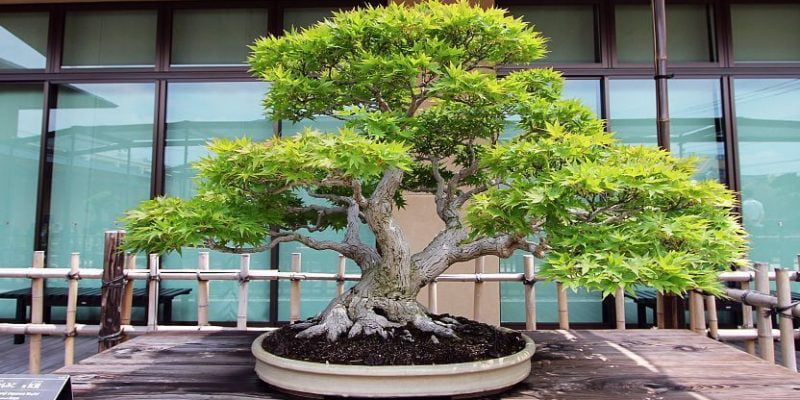




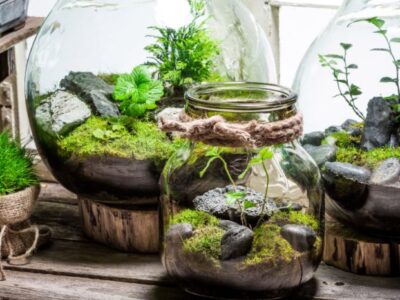


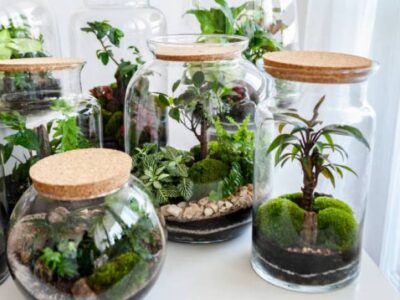
Comments